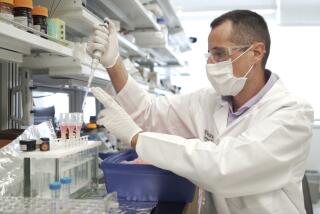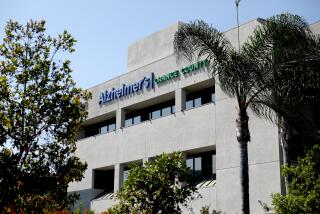Gene Discovery May Show How Alzheimer’s Develops
In a discovery that for the first time suggests a possible biological mechanism for Alzheimer’s disease, researchers have identified the first gene known to cause the most common form of the disorder.
The discovery “provides targets for new drug developments that would improve treatment of Alzheimer’s, and maybe even prevent it,” said Steven O. Moldin, acting chief of the genetics branch of the National Institute of Mental Health. “It’s going to jump-start the field . . . and lead to a flurry of intense activity in the next few months.”
The discovery involves what appears to be a sort of toxic waste removal system that clears a damaging protein fragment from the brain. When that system goes awry, the researchers theorize, toxic proteins accumulate and destroy brain cells, producing Alzheimer’s symptoms.
The system involves three proteins. Two of those are already known to be associated with familial Alzheimer’s disease--a relatively rare form of the disorder that strikes some individuals in their 50s and 60s. The third protein is produced by the newly discovered gene, called A2M. People with a defective form of the gene--and therefore a defective form of the key protein--are 3.5 times more likely to develop late-onset Alzheimer’s than those with the healthy form of the gene, according to a team of researchers based at Massachusetts General Hospital in Boston. The research was reported Wednesday at an international Alzheimer’s conference in Amsterdam.
The discovery “is very exciting because it provides a very clear set of biological pathways for Alzheimer’s that can be studied in animals,” Moldin said.
Late-onset Alzheimer’s, in which symptoms develop in a person’s 70s, 80s or later, is the type that afflicts more than 90% of the 4 million Americans with the devastating disorder.
In a related development, a second group of researchers reported evidence that the number of those suffering from Alzheimer’s is likely to grow substantially as the number of elderly in the population grows at unprecedented rates.
That study, by Johns Hopkins researchers, found that nearly half of all people who live to the age of 100 will develop Alzheimer’s.
Sharp Increase in Cases Predicted
Experts predict that the number of Alzheimer’s patients could leap to 14 million by 2050 unless researchers can find some way to delay or prevent its onset.
The researchers showed that a gene previously linked to Alzheimer’s, called APOE, does not influence susceptibility to the disorder, but rather controls the age at which the disease develops.
Both reports will appear in the Aug. 1 issue of Nature Genetics.
“This is an extremely exciting time in Alzheimer’s disease research,” said Zaven Khachaturian, director of the Alzheimer’s Assn.’s Ronald & Nancy Reagan Research Institute. “We’ve learned more about Alzheimer’s in the last two or three years than we did in the previous 30. The more we know about Alzheimer’s, the better we’re able to treat it, and eventually prevent and even cure it.”
Alzheimer’s is characterized by memory loss, disorientation, depression and a deterioration of bodily functions. It is ultimately fatal, causing about 100,000 deaths in the United States each year.
The key distinguishing characteristic of Alzheimer’s is the accumulation of waxy plaques, composed largely of a protein called beta-amyloid. Most scientists now agree that these plaques kill brain cells, thereby producing Alzheimer’s.
Geneticist Rudolph E. Tanzi and his colleagues at Massachusetts General Hospital used a new approach to identify the Alzheimer’s gene. They began by focusing on proteins that are known to interact with any of the three genes now linked to familial Alzheimer’s, which accounts for 1% to 10% of all Alzheimer’s cases.
They found that a well-known protein called alpha-2-microglobulin, or A2M, interacts strongly with proteins produced by two of the genes linked to familial Alzheimer’s. Those genes are called LRP and APOE. Studies in brain cells grown in the laboratory also demonstrated that the A2M protein forms a tight bond with a protein fragment called A-beta, which is the major component of amyloid plaques.
Armed with this background, they began studying tissue samples from 639 Alzheimer’s patients collected by the National Institute of Mental Health, comparing them to samples from 239 non-affected individuals.
They found that a particular mutation of the A2M gene, in which part of the gene is missing, was strongly associated with Alzheimer’s, producing the 3.5-fold increase in risk. “This finding leads us directly to a protein pathway that we think drives the Alzheimer’s disease process,” Tanzi said.
Tanzi speculates that the LRP protein sits in the synapses--the junctions where brain cells communicate with each other--and works with the A2M protein to break down A-beta fragments and remove them from brain cells.
“If a defective A2M kept the system from working properly, or if a variant of APOE blocked the usual breakdown process, A-beta plaques could form and clog the synapses--both slowing nerve signals and preventing the release of growth factors that keep cells healthy,” he said. This finding, Moldin said, “makes consistent biological sense and gives investigators a clear biological model to study in both animals and humans. And if it is validated, it may be possible to design a drug that replicates the normal action of A2M,” he added.
But experts cautioned that Alzheimer’s is a very complex disease and that several other genes are almost certainly involved as well. Some people with the A2M mutation do not develop Alzheimer’s, Tanzi noted, while others who have a healthy A2M do. Because of that, the gene cannot be used to screen for susceptibility, he said.
In the second study, Dr. John C. S. Breitner and his colleagues at the Johns Hopkins School of Public Health examined 4,932 elderly people, 694 of whom had Alzheimer’s. They determined which form of the APOE gene each of the subjects had. APOE naturally occurs in three variants, called 2, 3 and 4.
Each individual has two copies of the gene, one from each parent. Previous research had suggested that individuals with two copies of APOE-4 are the most likely to develop Alzheimer’s, while those who do not have it are least likely.
Based on their sample, Breitner’s team concluded that about half the population will eventually develop Alzheimer’s, whether they carry the APOE-4 gene or not. That estimate is consistent with other research. But Breitner and his colleagues also determined that which form of the APOE gene a person has determines the age at which he or she will develop the disease.
In the half of the population that appears to be predisposed to Alzheimer’s, the researchers found that people who carried two copies of APOE-4 either developed Alzheimer’s by the age of 85, or did not develop it at all.
Similarly, those with one copy of APOE-4 either developed it by age 95 or did not develop it at all. And those who had no copies either developed the disease by age 100 or did not develop it at all.
HEART DISEASE STUDY: Researchers have found a high heart disease hospitalization rate in the Southland. A3






